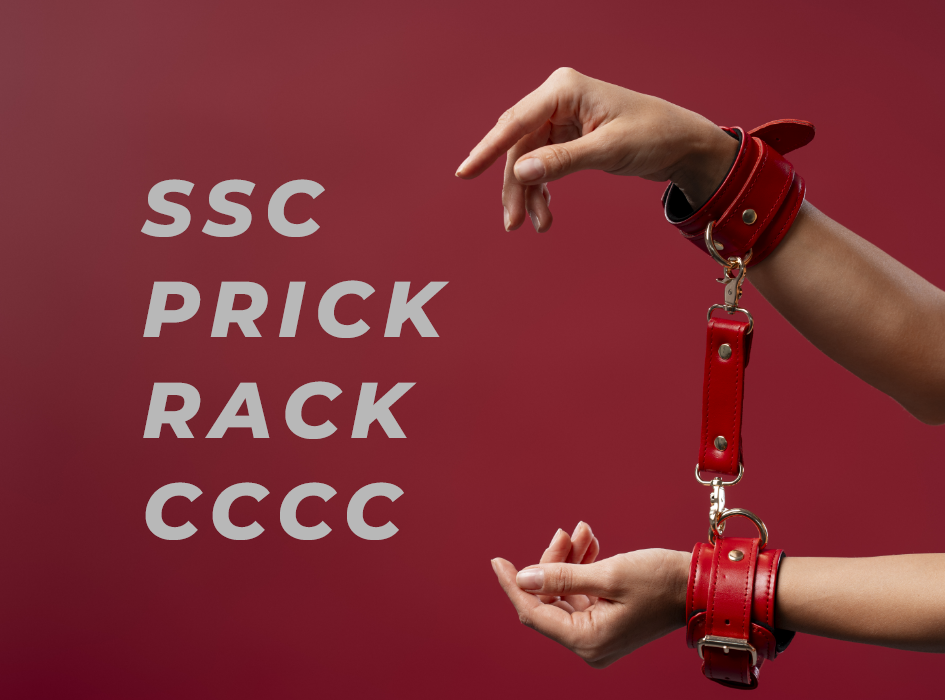Models like SSC, RACK, PRICK, and CCCC were developed to guide BDSM relationships. These acronyms help determine mutual expectations and shared responsibilities in play.
Are you curious about implementing one of these guidelines in your BDSM relationship? Or perhaps you're unsure which one to use? Here’s an overview of the four key models and their ideal use cases.
SSC, RACK, PRICK, and CCCC: Origins and Applications in the BDSM Community
In "Consensual Sadomasochism: How to Talk About It and How to Do It Safely," Henkin and Holiday explain that the term “Safe, Sane, and Consensual” (SSC) was coined by BDSM practitioners in the 1980s. This framework emphasizes that all activities should prioritize safety, involve consenting participants, and ensure everyone is of sound mind.
Why Safety and Consent Matter in BDSM
If you're new to the BDSM world, you might wonder why there's such emphasis on the nuances of different acronyms. Let's clarify: Safety and consent are paramount when partners exchange power during sexual play. These principles ensure no one is harmed physically or emotionally and help everyone feel comfortable exploring a wide range of kinks. These frameworks represent the BDSM community's effort to prioritize safety, ensuring the well-being of individuals and the community as a whole. By respecting these guidelines, we can continue to play safely and potentially earn more respect from the broader society.
A study by UBC Sexual Health Research underscores that consent is what distinguishes BDSM from abuse, highlighting an ongoing process to maintain safety.
“Consensual BDSM is predicated on explicit negotiation, which could be used as a model for discussing consent in other contexts,” the researchers assert. BDSM acronyms, from SSC to CCCC, serve as helpful tools in negotiating what makes you feel safest throughout a scene.
Now, let's break down each BDSM acronym to help you understand them better.
Breaking Down SSC
Safe, Sane, and Consensual (SSC) is a cornerstone of BDSM guidelines. Its primary ethos is that all activities involving power exchange should be safe, harmless, and agreed upon by all parties. The mutual consent implied in SSC empowers the BDSM community to explore their kinks while keeping compassion and respect at the center.
But what does this acronym really mean in practice? Let's break it down:
- Safe: Ensuring that all activities are conducted in a manner that minimizes physical and emotional harm.
- Sane: Engaging in activities that all participants are mentally capable of understanding and consenting to.
- Consensual: Having clear, informed, and voluntary agreement from all parties involved.
Safe Even in activities involving humiliation or impact play, practitioners should prioritize the well-being and security of everyone involved. According to Dr. Tara, sexologist and host of The LuvBites Podcast, “safe” can look different to everyone.
“I recommend that practitioners talk about the act in advance so that all participants can rate what is safe and what is not,” she says. “For example, if participants are going to try flogging, one can say, ‘for me, it’s safe to do it on my butt, but it’s not safe to do it on my pussy, neck, or near my face.’”
Sane Although this term has been criticized as ableist due to its mental health connotations, in BDSM it means that participants should be of sound mind, clear-headed, and capable of making thoughtful decisions on behalf of all parties.
Consensual Consent should be clearly and freely communicated before play begins, ensuring that all participants understand and respect the boundaries involved.
Breaking Down RACK
Building upon the principles of SSC, RACK stands for Risk-Aware Consensual Kink. It acknowledges that BDSM activities inherently involve risk and encourages individuals to take personal responsibility for their safety.
Gary Switch, a contributing editor for Prometheus Magazine, coined RACK in a post on The Eulenspiegel Society's USENET list, stating, “Nothing's perfectly safe. Crossing the street isn't perfectly safe. Remember if we want to limit BDSM to what's safe, we can't do anything more extreme than flogging somebody with a wet noodle.”
In essence, RACK expands on SSC by recognizing that many BDSM practices carry inherent risks. It emphasizes informed consent and encourages practitioners to mitigate risks through knowledge, skill, and personal judgment.
Breaking Down PRICK
PRICK, or Personal Responsibility, Informed, Consensual Kink, further develops the principles of RACK. It addresses concerns within the BDSM community about the completeness of consent when participants may not fully understand the risks involved.
Personal Responsibility
PRICK emphasizes personal accountability for all involved in BDSM activities, including dominants and submissives. It stresses the importance of educating oneself about potential risks and communicating honestly about boundaries.
Informed
Before engaging in new kinks under PRICK, individuals are encouraged to thoroughly research and understand the potential consequences. This includes learning about techniques, safety measures, and aftercare practices.
Consensual Kink
Consent remains central in PRICK, ensuring that all activities are agreed upon willingly and with full understanding of the risks involved.
Breaking Down CCCC
Diverging from SSC, RACK, and PRICK, CCCC stands for Caring, Communication, Consent, and Caution. This model offers a holistic approach to BDSM, emphasizing the importance of nurturing relationships, open communication, and mutual respect.
Proposed in the Electronic Journal of Human Sexuality in 2014, CCCC aims to address the relational aspects of BDSM more explicitly. It seeks to create a supportive and compassionate environment where participants prioritize each other's emotional and physical well-being.
Breaking Down the Four C's of CCCC
Caring
The introduction of "caring" distinguishes CCCC from RACK and PRICK. According to the authors who proposed CCCC, caring varies in intensity across different BDSM relationships. Whether it's a Total Power Exchange (TPE) partnership or a casual play arrangement, CCCC acknowledges a fundamental caring for fellow human beings. This stands in contrast to external perceptions that BDSM might be seen as inherently abusive or pathological. The emphasis on caring underscores that BDSM relationships can and should prioritize compassion and mutual respect.
Communication
Communication is highlighted as a fundamental pillar within BDSM dynamics in CCCC. The model suggests that understanding your partner's needs and motivations through effective communication leads to more fulfilling sexual experiences, whether engaging in BDSM or vanilla sex.
Consent
While consent is central to SSC, RACK, and PRICK, CCCC challenges practitioners to adopt a more nuanced understanding of consent. It encourages deeper reflection on what constitutes consent beyond mere verbal affirmation or the use of a safeword. CCCC prompts consideration of non-verbal cues and the impact of BDSM activities on a participant's mental and emotional state.
"We are discussing more than a bottom's ability to signal 'red'," the journal notes. "In situations where a bottom may be crying, in distress, or experiencing subspace without explicitly using a safeword, practitioners must assess the extent to which cognitive consent is feasible."
Caution
In contrast to the focus on safety and risk-awareness in RACK and PRICK, CCCC shifts towards caution. This subtle change encompasses a broader spectrum of social considerations beyond physical safety. It encourages individuals to evaluate which BDSM activities feel emotionally, psychologically, and socially safe and healthy for them.
Related posts
-
Acronyms of BDSM : A Look at SSC, RACK, PRICK and CCCC
BDSM acronyms have emerged and been debated over a time as away to protect BDSM......
-
Is It Common to Lose an Erection When Wearing a Condom?
Have you ever been ready to go, but lost your erection when putting on a......
-
Is the Idea of a Cuckquean Rooted in Myth or Real-life Practices?
A cuckquean is a woman whose husband is unfaithful, often with her knowledge and sometimes......


